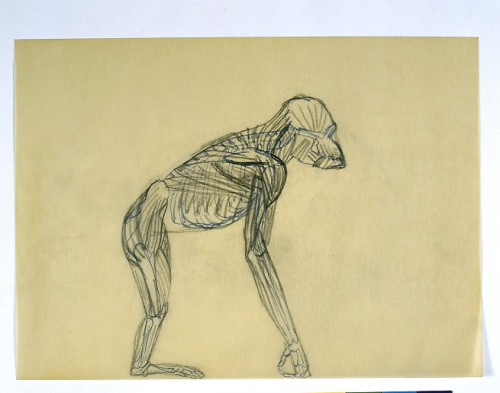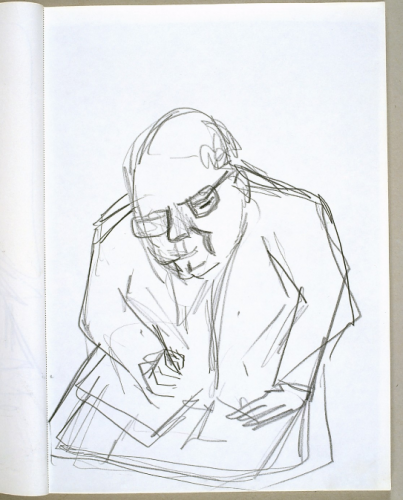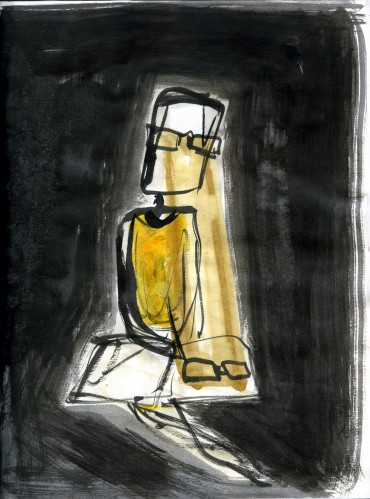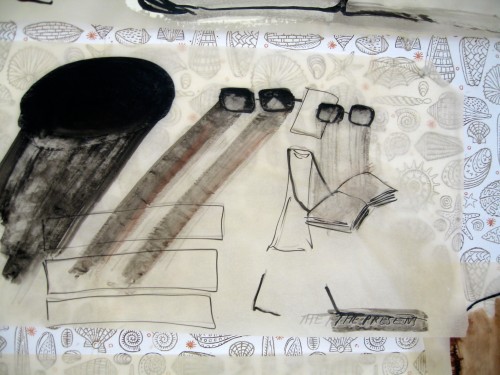I had a hard time finding decent images of Dix’s work online, starting with the Neue Galerie exhibition site, continuing with the Metropolitan Museum website which only reproduces one work. I assume this is done precisely in order to prevent people like me from lifting the images off the web for their own purposes.
However one web source of images of works by Otto Dix is exceptionally interesting to anyone who appreciates drawing and I think it will make drawing interesting to anyone else: bildindex der Kunst und Architektur has over 3000 Dix images, some are black and white reproductions of drawings in various collections, including drawings that are currently in the Otto Dix exhibition at the Neue Galerie but many are hi-res images of Dix’s sketchbook drawings which give an insight into the experience and the preparatory work that went into Dix’s paintings, although some patience is involved with seeing any of them beyond a thumbnail. Some are amazing artworks in themselves but all are instructive of a constant lifelong practice. Many are what might seem like academic studies, but that characteristic in itself gives some insight into Dix’s style as well, the style he chose for its expressivity and political subtext (the Gothic or Northern Renaissance elongated, detailed style of figuration) — that is to say the style we most associate with Dix was not only an unconscious signature, it was also a deliberate aesthetic and historical choice built on a base of more traditional or conventional academic skills. Many of the drawings on this site are from the 1950s and ’60s, a period of Dix’s work that is not well-known, at least in the US.
In an earlier post I spoke of art works that I love because of characteristics that propel me back into my own studio practice. One type of work I seek is a work that makes me want to work, that, no matter how simple, gives me permission or inspiration. It can be as modest as the single stroke of charcoal on a drawing by Guston. Strangely it is among the hundreds of sketchbook drawings by Dix on this website, rather than in the paintings, that I feel I may have found a few such inspiring works for my current work. Perhaps the tide of history had moved past Dix or had only for a brief moment incorporated him, perhaps his later work was more conventional, I don’t know enough, having mainly these sketches to go by. But I feel that there is something of use for me in the simplicity of these sketches, their formal clarity without the earlier Gothic mannerism.

Otto Dix, Anatomischer Affe, sketchbook drawing, 1954

Otto Dix, Drawing of Composer Wolfgang Fortner,1967

Otto Dix, Drawing, c. 1967
Full disclosure: perhaps it’s not surprising that at the moment I’m drawn to a sketchbook drawing of a person writing or drawing on pages or notebooks because I’ve been drawing in sketchbooks myself drawing in sketchbooks. I include this image not in any way to compare myself with Dix, except that I share a love of drawing and at many times it has been a crucial area of practice, not only preparatory for painting but in itself, for what ink, gouache, various other media and different kinds of paper can do in particular.

Mira Schor, Night Drawing, 2009, ink on paper, 8 1/2" x 11," sketchbook drawing
A few years ago, in the mid-0s, my colleagues and I were treated to a PowerPoint presentation on some changes to the school’s foundation year program, which, it should noted, services many areas, of which fine art is the smallest. At that time PowerPoint was enough of a novelty in itself that we could, unfortunately not for the last time, exclaim with wonder that the speaker actually was MAKING US READ THE TEXT he was speaking out loud, keeping the slides of his exact spoken words up interminably, as if we were not college professors with some basic degree of literacy, thereby unconsciously performing one underlying purpose of this talk, which was to signal the institution’s embrace of visual culture’s ahistorical sampling of morphologically-related images (a lively phantasmagoria of everything from Marie Antoinette’s coiffures to Bruce Nauman sculptures to the latest chair design but not a single painting) over any kind of discipline-based art or design practice, which we were collectively thought to be representing in our work and teaching.
Under the circumstances, I was struck by the speaker’s use of the word “ideation” as a substitute for the word drawing. It stuck in my head partly because it is sort of a cool word, with its pseudo-scientific and vaguely military/corporate buzz. On the other hand it’s somewhere between annoying and sinister in its implications to art making. While it places an interesting emphasis on the undeniable conceptual aspects of drawing, the goal of disembodiment implicit in its privileging of the instrumental and utilitarian aspects of drawing — as a space where you could “ideate” something else, a means to another end than itself, rather than conceptualism recognized as part of the process internal to the practice of drawing itself — shifts the emphasis away from the craft or artisanal aspect of drawing as something done by the artist’s body from brain through hand to viewer’s eye, body sense, and mind. And ideation not only replaces the word drawing but also the word thinking. “I’m ideating” is an absurd answer to the question, What are you doing?, whether you are drawing or thinking.
It’s true that I use drawing as a space for ideation of painting and of externalization of otherwise inchoate ideas in my head (mostly for painting but sometimes I start an essay with a diagram while many of my drawings have a diagrammatic aspect and function for me). As many artists and architects have experienced, drawing is a space for experimentation, where failure and error are not so much concerns or fears as they are goals. There is an immediacy and often an intimacy in drawing and like many painters I am often hard put to achieve the same qualities in oil painting because the medium has an imposing presence and history and it is a substance that, although also unusually fluid and sensual, resists, although that is part of the appeal of oil painting for me, its resistance, its unwieldy, stubborn objectness.
While I was working on this blog entry yesterday, with drawing on my mind, I went through the pile of drawings I’ve just been doing and put them up on my studio wall rather than keeping them floating around the floor and tables. That is, I decided to stop waiting to privilege the ends (“finished” paintings) and took a moment of pleasure in the means (hit and miss drawings). Doing so helped me to perceive that I was in fact working, a recognition that hits an important gear in the process of getting back to studio work after a long interruption, as is the case this year. This was a small moment when doing the project A Year of Positive Thinking yielded a small but welcome positive moment in my work process which is, in a sense, a total ideation across several platforms.

Mira Schor, The Present, 2010, ink on tracing paper, 12″ x 18,” (my studio in Provincetown has a 1950s era shell-theme wallpaper that I’ve grown very attached to).

Mira Schor, Drawings, or should I say Ideations, Studio Wall, July 4, 2010
